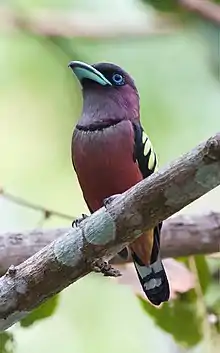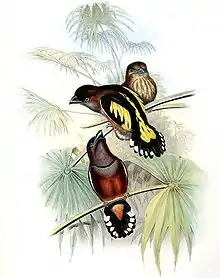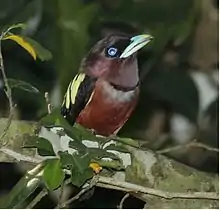Banded broadbill
The banded broadbill (Eurylaimus javanicus), is a species of bird in the family Eurylaimidae. It is found in Brunei, Cambodia, Indonesia, Laos, Malaysia, Myanmar, Singapore, Thailand, and Vietnam. Its natural habitat is subtropical or tropical moist lowland forests. It is a large broadbill (21.5–23 cm), with purple, yellow and black plumage. It eats predominantly insects, including grasshoppers, crickets, katydids, various beetles, caterpillars and larvae.[3]
| Banded broadbill | |
|---|---|
 | |
| Male | |
| Scientific classification | |
| Kingdom: | Animalia |
| Phylum: | Chordata |
| Class: | Aves |
| Order: | Passeriformes |
| Family: | Eurylaimidae |
| Genus: | Eurylaimus |
| Species: | E. javanicus |
| Binomial name | |
| Eurylaimus javanicus Horsfield, 1821 | |
 | |
| Range of the banded broadbill | |
| Synonyms[2] | |
Taxonomy and systematics

The banded broadbill was described as Eurylaimus javanicus by the American naturalist Thomas Horsfield in 1821 based on specimens from Java. It is the type species of the genus Eurylaimus, which was created for it.[4] The generic name Eurylaimus comes from the Ancient Greek ευρυς (eurus), meaning broad, and λαιμος (laimos), meaning throat. The specific name javanicus comes from Java, the island on which it was discovered.[5] Banded broadbill is the official common name designated by the International Ornithologists' Union (IOU).[6] Other common names for the species include Javan broadbill.[7] The species is called takau rimba in Malay and Nok Phaya Paak Kwaang laay leuang in Thai.[8]
The banded broadbill is one of two species currently placed in the genus Eurylaimus, in the typical broadbill family Eurylamidae, a family of nine tropical species native to Southeast Asia.[9] Based on a 2017 study by the Brazilian researcher Alexandre Selvatti and colleagues, its closest relative is the black-and-yellow broadbill. These two species are most closely related to a clade formed by the black-and-red and silver-breasted broadbills, and all three genera form a sister clade to the genus Sarcophanops. This clade is sister to one formed by the long-tailed broadbill and dusky broadbill. Both of these clades are sister to the Grauer's broadbill. The following cladogram shows phylogenetic relationships among the Eurylaimidae, based on the above study:[lower-alpha 1][11]
| Eurylaimidae |
| ||||||||||||||||||||||||||||||||||||||||||
Four subspecies of the banded broadbill are currently recognised by the IOU:[6]
- E. j. pallidus Chasen, 1935: Found from southeastern Myanmar to Vietnam and the Malay Peninsula.[6] Populations from the northern Malay Peninsula are sometimes separated as E. j. friedmanni.[12]
- E. j. harterti van Oort, 1909: Found on Sumatra, the Riau Archipelago, Bangka Island, and Belitung.[6] The population from Belitung was previously recognised as E. j. billitonis, but this is not generally accepted anymore.[12] It is larger than the nominate subspecies, with light blue-green irises, darker underparts, a more reddish upper back, and pink vent.[13]
- E. j. javanicus Horsfield, 1821: Also known as the Javan broadbill, it is the nominate subspecies and found on Java.[6]
- E. j. brookei Robinson & Kloss, 1919: Found on Borneo and the northern Natuna Islands.[6]
All the subspecies excluding javanicus are sometimes split as a separate species, which would make the current species monotypic (having only one subspecies).[13]

Description
The banded broadbill is a striking, large-bodied bird, with a length of 21.5–23.0 cm (8.5–9.1 in). The weight of adults of pallidus from the Malay Peninsula was 65.1–95.0 g (2.30–3.35 oz), with males weighing slightly more than females. If seen clearly, the species is unlikely to be confused with any other bird. It may be mistaken for black-and-yellow broadbill, which differs in its smaller size, black head, and contrasting white collar.[13]
Adult males of the nominate subspecies have a glossy purple-red head, which turns black towards the lores and base of the bill. The chin, throat, and ear-coverts are slightly lighter, with a black band across the neck. The top of the head is glossy maroon black and turns grey towards the back of the neck. The upper back is maroon-tinged dark brown, with most of the back black, except for a central line of yellow streaks. The primary feathers are dark brown, with thin yellow edges that are present as a yellow line on the bend of the wing. The remaining wing-coverts are blackish, with yellowish markings. The secondaries have bright yellow edges to their outer margins that form a well-marked, trapezoidal patch on the wing. The underparts are pale pinkish-violet to wine-red, with a grey tinge to the chin and upper breast and a pure grey breast-band. The tail is dark black and has white spots on the underside, while the undertail-coverts are pale yellow and the rump has a variable black and yellow pattern. The brilliant turquoise blue beak is broad and hooked, edged green or black. The irises are pale yellow in javanicus and sapphire blue in all other subspecies, while the legs are pale pinkish-brown to light greyish-blue with dull black feathering.[8][13]
Females are similar to males, but can be told apart by their lack of a neckband and greyer heads and underparts, although the neckband is faint or absent in males as well on Borneo and Java. Juveniles have pale brown heads, brown upper backs, dark brown wings, and black tails. They have a marked yellow supercilium that widens towards the back of the neck to become a broken collar, while the ear-coverts have narrow yellow streaks. The upper back has irregular yellow spots and the back and rump are largely yellow. The wings have yellowish markings like those of adults. The throat is yellowish with pale dark streaks and is separated from the breast by a yellowish-white strip, the rest of the underparts being a pink-tinted yellow. The bill is orangish-brown. As juveniles age, the yellow on the body is gradually replaced with purple-pink, starting with the head and side of the neck. In Malaysia, moulting has been observed in all months except January and February and peaks from May to August. The primary feathers nearest the body are moulted first, with those further away mounting later.[8][13]
Reddish colours in the banded broadbill's plumage are caused by the biological pigment 2,3-didehydro-papilioerythrinone, which is also found in the black-and-yellow broadbill, black-and-red broadbill, and Sarcophanops species. The yellow in the species' plumage is caused by the carotenoid 7,8-dihydro-3′-dehydro-lutein, which is also present in the plumage of the black-and-yellow broadbill.[14]
Behaviour and ecology
Despite the banded broadbill's distinctive and conspicuous coloration, it is generally hard to observe due to its lethargic habits and is generally only seen due to its loud song.[13] It is known to make wing and gaping displays similar to those of the black-and-yellow broadbill. Wing displays include raising the wings slightly above the back and then slowly opening and closing the flight feathers, and are made after singing, foraging, or in response to playback. They may include just one wing and are sometimes complemented with a tail wag. Gaping displays are conducted by opening and closing the bill measuredly without making any sounds. They displays are performed both when alone and in the presence of other banded broadbills, and have been observed being performed near nests. They are also sometimes accompanied by soft calls.[15]
Feeding
The banded broadbill feeds on a variety of food, including arthropods, small vertebrates, and fruit. Its main prey is orthopterans (grasshoppers, katydids, and crickets) with an average length of 55 mm (2.2 in). It also feeds on true bugs (Hemiptera), snails, spiders, and beetles such as ground beetles (Carabidae), darkling beetles (Tenebrionidae), and true weevils (Curculionidae). Small fruit like Ficus figs are also eaten, although their importance in the species' diet is unknown. The broadbill has been recorded eating lizards up to 10 cm (3.9 in) long and frogs, eating both head-first.[8][13]
Like other broadbills, the species forages in a sluggish manner. It has a toothed bill-tip and spends the majority of its time still-hunting, taking off from high perches and grabbing prey from nearby branches and the undersides of leaves. Except for probing head movements, often upwards, the broadbill is generally motionless. It has been observed making erratic, fluttering flights to glean prey before perching again, as well as catching prey in flight in more elegantly. Pairs and small flocks that are thought to be family groups are active throughout the day, occasionally joining mixed-species foraging flocks.[8][13]
Breeding
On the Malay Peninsula, breeding in the banded broadbill usually takes place in the dry season following the East Asian Monsoon. The only recorded nest from Myanmar was observed in Tenasserim on 21 March. In Peninsular Malaysia, nests have been seen in February and March and immatures from early April to early September, extrapolating to eggs being laid from March to May and in July. Observances of nests and immatures in Thailand are at later times than in Malaysia, reflecting the passage of the monsoon. In Laos, immatures have been seen in June, indicating that breeding took place at the beginning of the wet season, instead of the dry season like the rest of the peninsula. The breeding season is lengthier on the Greater Sunda Islands, lasting from March to November. On Borneo, adults have been observed collecting nesting material in March and a recently fledged bird was seen in September, while males with enlarged testicles have been collected from March to July. The banded broadbill's breeding season is particularly prolonged on Sumatra and Java. Immatures have been observed in March, July, September, and November on Sumatra and eggs have been collected from Belitung in April. On Java, the species may breed throughout the year, with nests collected in April, June, and December and immatures between March and December.[8][13]
Like other typical broadbills, the banded broadbill's nests are usually made at a height of 6–21 m (20–69 ft) over clearings or water bodies, hanging from dead or living trees like dipeterocarps and Koompassia excelsa. They have also been recorded being built on epiphytes like Pandanus, ferns, and bamboo. Nests are generally hung from a lateral branch close to the trunk, but are sometimes also suspended from thick leaves and bamboo tips. Nests have been observed being built close to the beehives of species like the giant honey bee (Apis dorsata) and Halictidae sweat bees, a strategy that is also seen in the black-and-yellow broadbill and which may provide protection. One nest in Borneo was observed being built over a period of 18 days, with both adults participating in nest-building. The nests are large, raggedy, and ovoid or pear-shaped, with a total length of 75–90 cm (30–35 in), including the trailing tail. Materials used to make the nest include leaves, twigs, roots, fibers, moss, leaf skeletons, grass stems, and bryophytes. The inner chamber is covered with leaves and thick grass stems, while the outside is embellished with lichen, bryophytes, green moss, insect excreta, cocoons, and cobwebs, presumably to provide camouflage. The entrances to the nest are covered by a slanting eave. A nest from Sabah had a height of 25 cm (9.8 in), a width of 22.5 cm (8.9 in), and a depth of 15 cm (5.9 in), with an entrance measuring 54 mm × 58 mm (2.1 in × 2.3 in).[8][13]
The banded broadbill's eggs are oval-shaped and measure 26.1 mm–31.5 mm × 17.1 mm–22.2 mm (1.03 in–1.24 in × 0.67 in–0.87 in). They have a smooth and slightly shiny surface and are usually dull white with dark purple or reddish-brown flecks, denser at the wide end. However, West Javan eggs are dirty white, sometimes tinged pink, with dense rusty-brown to lavender-gray markings concentrated at the broader end. Clutches have generally two or three eggs, although they may sometimes have more. Incubation can start before the completion of the nest and one bout of incubation was recorded being 1.8 hours long. Little is known about the species' hatching and parental care, but parents continue to provide 70–80% of food to young 13 weeks after fledging, reducing to 20–30% by 20 weeks.[8][13]
Status
The International Union for Conservation of Nature, which splits the banded broadbill into two species, classifies javanicus as being near-threatened and the other subspecies as being of least concern.[1][16]
Notes
- The study did not include the Visayan broadbill, which was formerly considered conspecific with the wattled broadbill.[10]
References
- BirdLife International (2016). "Eurylaimus javanicus". IUCN Red List of Threatened Species. 2016: e.T103656944A104031815. doi:10.2305/IUCN.UK.2016-3.RLTS.T103656944A104031815.en. Retrieved 12 November 2021.
- Dekker, René W. R. J.; Dickinson, Edward C.; Eck, Siegfried; Somadikarta, Soekarja (2000). "Systematic notes on Asian birds. 3. Types of the Eurylaimidae" (PDF). Zoologische Verhandelingen (331): 80. ISSN 0024-1652. Archived (PDF) from the original on 11 May 2021. Retrieved 2022-04-16.
- Bruce, M.D (2003b): 10. Banded Broadbill. In: del Hoyo, Josep; Elliott, Andrew & Christie, David A. (eds.): Handbook of Birds of the World (Vol. 8: Broadbills to Tapaculos): 10, plate 2. Lynx Edicions, Barcelona. ISBN 84-87334-50-4
- Horsfield, Thomas (1821). "Systematic arrangement and description of birds from the island of Java". Transactions of the Linnean Society of London. 13 (1): 133–200. doi:10.1111/j.1095-8339.1821.tb00061.x – via Biodiversity Heritage Library.
- Jobling, James A. (2010). Helm Dictionary of Scientific Bird Names. London: Christopher Helm. pp. 154, 211. ISBN 978-1-4081-2501-4. OCLC 1040808348 – via Biodiversity Heritage Library.
- Gill, Frank; Donsker, David; Rasmussen, Pamela, eds. (2022-02-01). "NZ wrens, Sapayoa, broadbills, asities, pittas". IOC World Bird List. Retrieved 2021-07-07.
- "Eurylaimus javanicus (Banded Broadbill)". Avibase. Archived from the original on 2011-09-24. Retrieved 2021-12-30.
- Wells, David R. (2010). The Birds of the Thai-Malay Peninsula Vol. 2: Passerines. London: Bloomsbury Publishing. pp. 56–58. ISBN 9781408133132. OCLC 659739244.
- Winkler, David W.; Billerman, Shawn M.; Lovette, Irby J. (2020-03-04). Billerman, Shawn M.; Keeney, Brooke K.; Rodewald, Paul G.; Schulenberg, Thomas S. (eds.). "Asian and Grauer's Broadbills (Eurylaimidae)". Birds of the World. Cornell Lab of Ornithology. doi:10.2173/bow.euryla1.01. Retrieved 2022-04-16.
- Cottrell, G. William; Greenway, James C.; Mayr, Ernst; Paynter, Raymond A.; Peters, James Lee; Traylor, Melvin A. (1951). Check-list of birds of the world. Vol. 7. Cambridge: Harvard University Press. p. 9. Archived from the original on 19 January 2022. Retrieved 19 January 2022.
- Selvatti, A.P.; Galvão, A.; Pereira, A.G.; Pedreira Gonzaga, L.; Russo, C.A.D.M. (2017). "An African origin of the Eurylaimides (Passeriformes) and the successful diversification of the ground-foraging pittas (Pittidae)". Molecular Biology and Evolution. 34 (2): 483–499. doi:10.1093/molbev/msw250. PMID 28069777.
- Dekker, René W.R.J.; Dickinson, Edward C. (2000). "Systematic notes on Asian birds. 2. A preliminary review of the Eurylaimidae" (PDF). Zoologische Verhandelingen (331): 65–76.
- Kirwan, Guy M.; del Hoyo, Josep; Bruce, Murray D.; Collar, Nigel (2021-07-16). Billerman, Shawn M.; Keeney, Brooke K.; Rodewald, Paul G.; Schulenberg, Thomas S. (eds.). "Banded Broadbill (Eurylaimus javanicus)". Birds of the World. Cornell Lab of Ornithology. doi:10.2173/bow.banbro1.02. Retrieved 2021-12-31.
- Prum, Richard O.; LaFountain, Amy M.; Berg, Christopher J.; Tauber, Michael J.; Frank, Harry A. (2014). "Mechanism of carotenoid coloration in the brightly colored plumages of broadbills (Eurylaimidae)". Journal of Comparative Physiology B. 184 (5): 651–672. doi:10.1007/s00360-014-0816-1. ISSN 0174-1578. PMID 24647990. S2CID 18907522. Archived from the original on 1 January 2022. Retrieved 2022-04-18.
- Gulson-Castillo, Eric R.; Pegan, Teresa M.; Greig, Emma I.; Hite, Justin M.; Hruska, Jack P.; Kapoor, Julian A.; Orzechowski, Sophia C.; Shipley, J. Ryan; Winkler, David W. (2019-03-15). "Notes on nesting, territoriality and behaviour of broadbills (Eurylaimidae, Calyptomenidae) and pittas (Pittidae) in Tawau Hills Park, Sabah, Malaysian Borneo". Bulletin of the British Ornithologists' Club. 139 (1): 11–15. doi:10.25226/bboc.v139i1.2019.a1. ISSN 0007-1595. S2CID 133794807. Archived from the original on 2021-12-13. Retrieved 2022-05-02 – via BioOne.
- BirdLife International. (2016). "Eurylaimus harterti". IUCN Red List of Threatened Species. 2016: e.T103656950A93700674. doi:10.2305/IUCN.UK.2016-3.RLTS.T103656950A93700674.en. Retrieved 18 April 2022.
